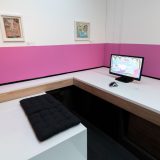Travelling Gallery’s third 2023 exhibition was the group show Take Care, which explored our relationship to the non-human things we care for in an often isolated society.
Gwenan Davies’ still lifes take on an almost landscape quality as we survey the view of abandoned coffee cups. The scene has become synonymous with our coffee breaks but feels isolated without a human figure present and makes us think about how we inhabit that space. Davies is interested in the ‘in-between’ time and how we perform the ritual of the coffee break in a man-made, capitalist environment with each coffee shop mimicking the last with inauthentic tropes like artificial tulips. However, rather than critique, Davies embraces these structures of the everyday and observes their social function, turning the mock wooden laminate and coffee shop props into fascinating paintings. Diaristic in format, some paintings take days to complete, others months; and time is reflected on the painting’s surface, showing the changes from previous layers – no one moment sticks. The final works become markers of time, both active and passive, and something in-between.
Exploring the intimacy of baking, artist Laura Wilson exhibited a new video using footage from her 2018 performance You would almost expect to find it Warm. The performance, which took place at the British Museum, London, presents growing, gloopy, fresh dough as a living organism that is alive with yeast and performs with dancers dressed in light blue overalls. With a resemblance to human flesh or the marble that fills the British Museum the performative dough slowly moves its way through the choreography in careful collaboration with its human partner.
The video work is accompanied by two large pencil drawings showing the human and non-human forms gently resting upon each other and the way in which the weight and comfort of the dough is felt. By understanding the dough as a living material, Wilson’s work explores our intimate relationship to food and the politics related to what we eat and how we consume it.
Continuing our relationship to non-human things, artist Uma Breakdown presented their video game Animal Agency made using stop motion animation from original drawings. Animal Agency is a free, downloadable video game inspired by the idea that animals can be recognised autonomously, outside of their relationships with humans. A challenging concept in a society where the human and animal bond is seen as mutually beneficial. The multi-layered click and point video game invites the player to work with animal-like creatures to move between a number of rooms and spaces where it’s easy to get lost and the game conjures up feelings reminiscent of the COVID-19 pandemic; the feeling of being trapped and tired. However, Animal Agency also highlights the fun interactions we gain from our pets and activities like gaming.
Exhibited alongside Animal Agency are some original drawings by Uma Breakdown. The drawings depict other non-human, sci-fi like creatures and are inspired by Breakdown’s interest in horror. Rather than only looking at the gore and scares of horror, Breakdown explores the moments of care and affection which are often found between characters whether human or not.
Another non-human life form that populates our homes is the humble house plant. Our care (or lack of) was explored in the moving image work Plantarians: appendix by Ellie Kyungran Heo. Kyungran Heo is a multimedia artist who explores the environmental and social systems that shape our coexistence with nature. In the film a human is squeezed into a tiny room and tries with difficulty to move and stretch their limbs. The film was accompanied by a source image of a modest houseplant with entangled, dried out roots, and the question “Why is it that we place a plant in a pot, constricting its ability to grow and occupy physical space?”. By imagining what it’s like to be in the crushed confines of a plant pot we begin to build empathy for our non-human house mate and consider our role as carer, ensuring it gets nutrients from soil and water.
Finally, Travelling Gallery collaborated with Sculpture Placement Group (SPG) to exhibit a sculpture from their Loan Scheme. Here, My waiting by Joy Baek is inspired by her memories of visiting elders’ homes where they usually lived alone. Revisiting her emotions and memory of that time, Beak remembers the kind hospitality of the elders and the poignant warmth that she felt.
The SPG Loan scheme works with artists to extend the life-cycle of artworks that are currently in long-term storage, allowing people to care for and enjoy an artwork, often outside of a gallery context. When exploring our relationship with non-human things and places – animals, dough, plants – we wanted to think about our immediate surroundings in the Travelling Gallery and ask about our relationship to artworks. What enjoyment do we get from artwork and how do we care for it?











